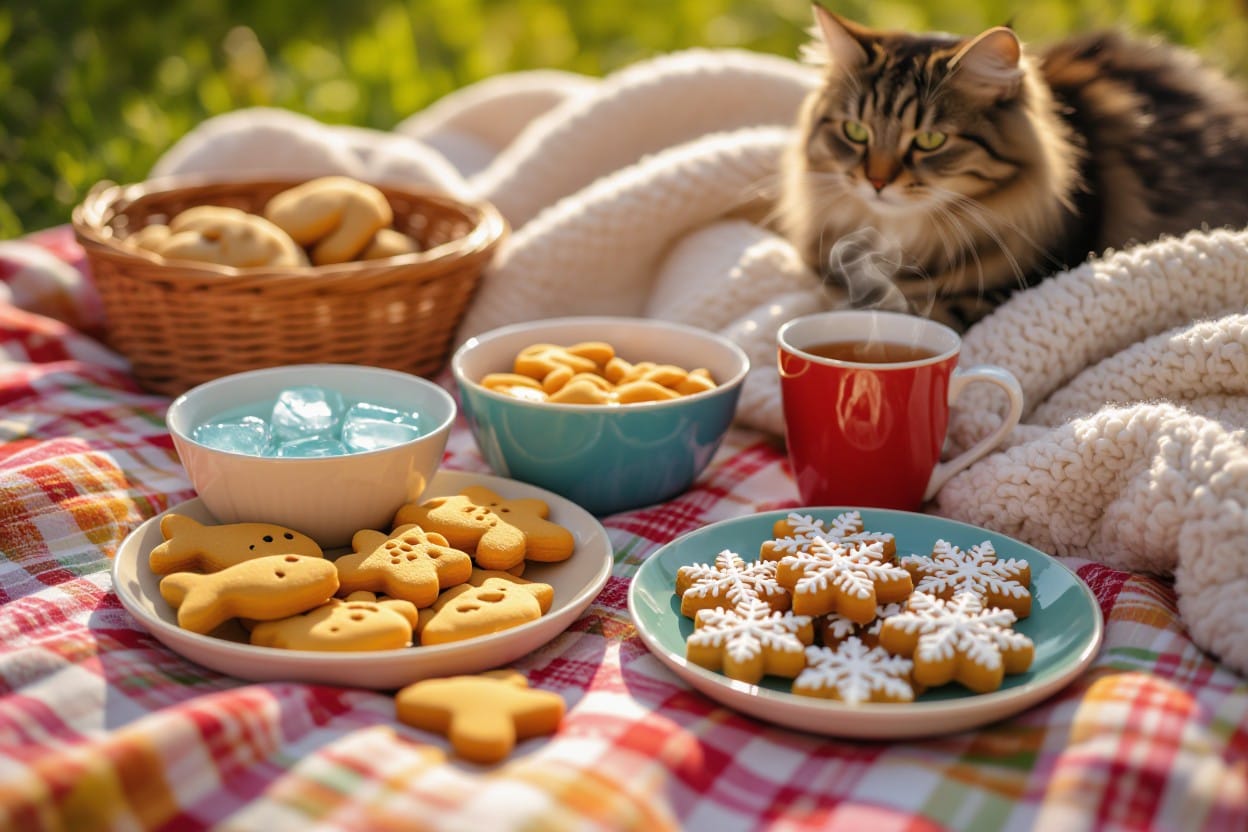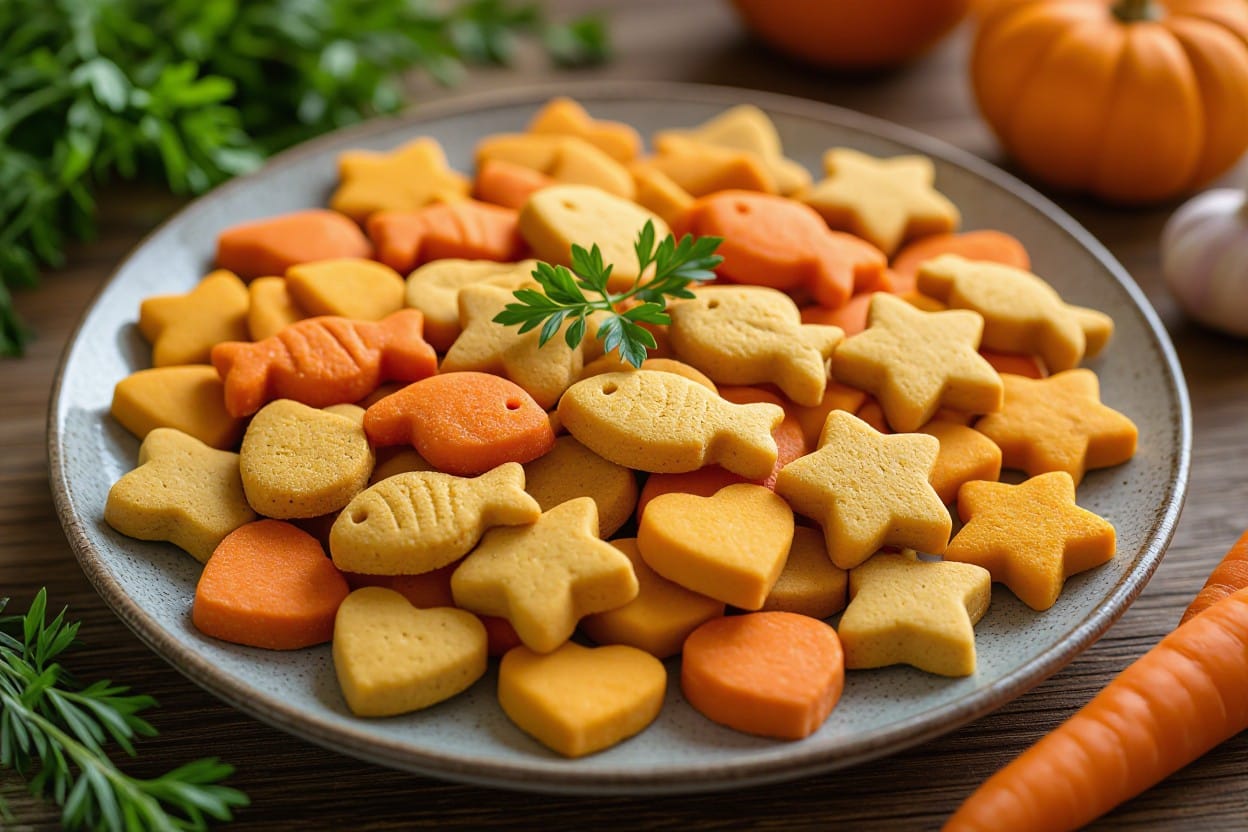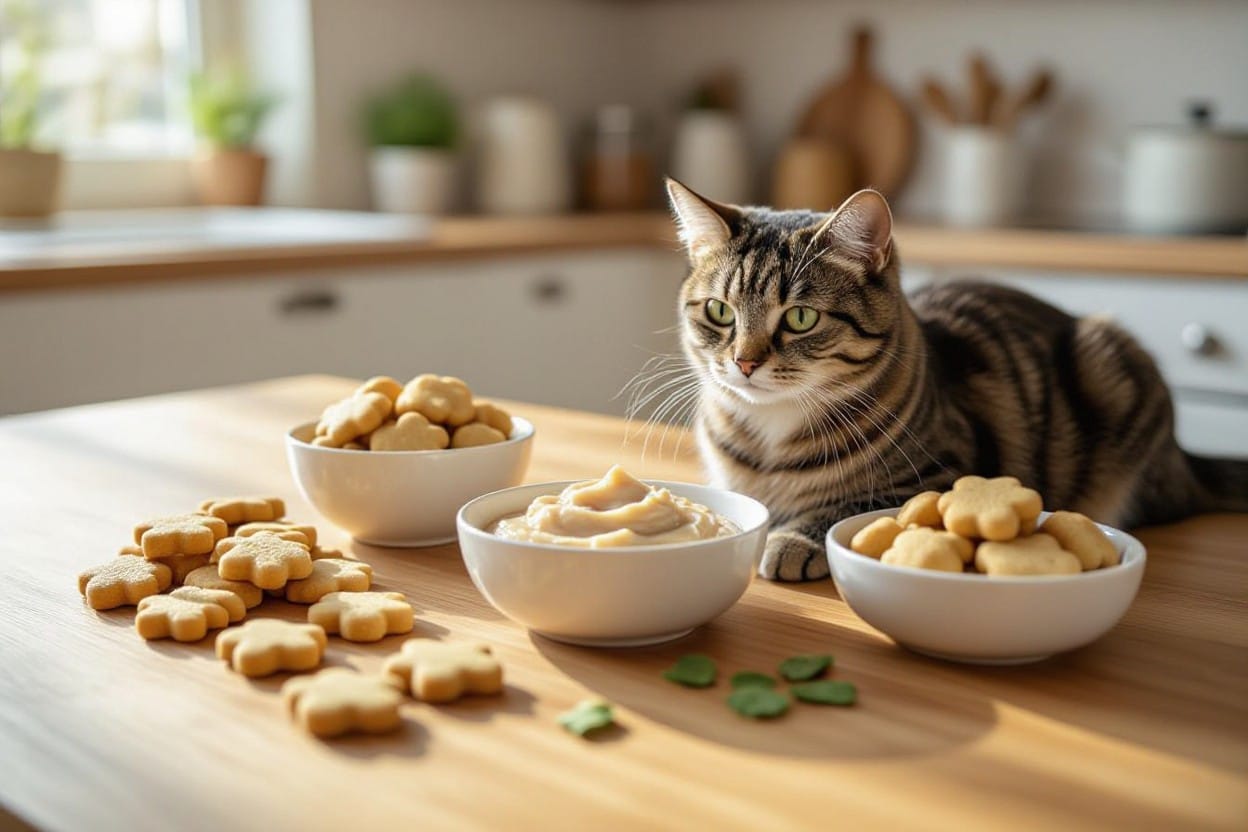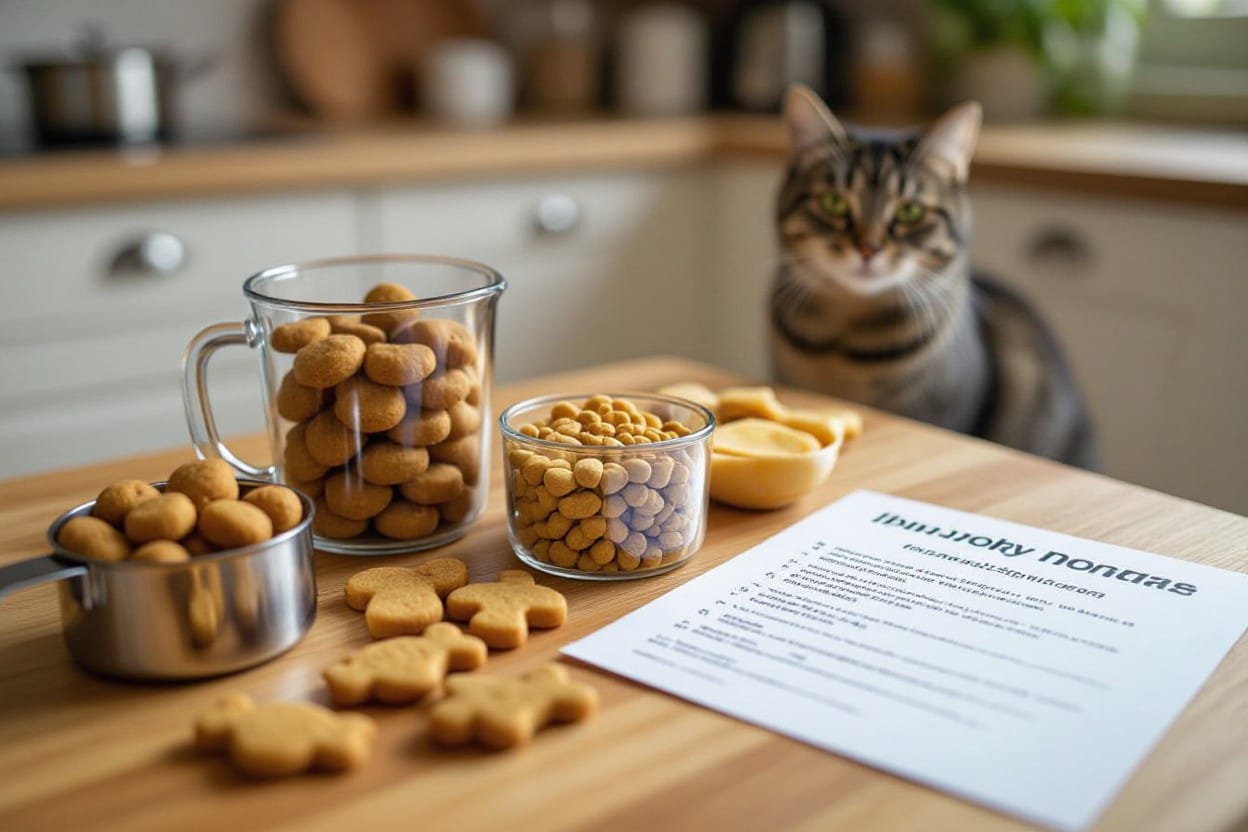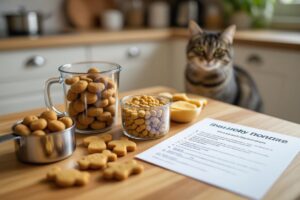Recipes guide you to create simple, vet-friendly cooling treats for cats and comforting winter warming cat treats, using seasonal cat recipes so your cat stays hydrated and cozy. For summer cat treats try frozen cat treats homemade summer made from low-sodium broth and plain pumpkin; for winter opt for warm cat treats winter recipes with cooked fish or poultry. Always avoid onion, garlic, chocolate, xylitol and grapes and consult your vet about allergies and portion sizes.
Key Takeaways:
- Focus on hydrating, pet-safe ingredients when making cooling treats for cats and summer cat treats — try frozen cat treats homemade summer recipes using plain broth, pureed fruit (cat-safe), or yogurt alternatives to help cats beat heat.
- Offer small, nutrient-rich winter warming cat treats and warm cat treats winter recipes to support appetite and circulation — simple warmed broths, mashed cooked proteins, or oatmeal mixes make effective comfort snacks.
- Plan seasonal cat recipes that prioritize portion control, ingredient safety, and easy storage; rotate frozen summer options and refrigerated or gently warmed winter recipes for variety and consistency.
Seasonal Nutrition for Cats
Temperature Regulation
How temperature affects physiology and the dietary actions you can take
| Physiological response | Practical dietary / treat actions |
| Normal feline body temp: 100.5–102.5°F (38–39.2°C); limited sweat glands, rely on grooming and respiration to cool. | Offer high-moisture foods (canned or broths) and frozen cat treats homemade summer like ice cubes made from tuna water to increase hydration and lower body heat. |
| Heat stress increases risk of dehydration and heatstroke; signs include panting, drooling, weakness. | Provide multiple water sources, chilled wet food, and avoid dry-only diets in hot months; monitor for danger signs such as lethargy and rapid breathing. |
| Cold exposure increases metabolic demand to maintain temperature. | Introduce energy-dense, warm meals and warm cat treats winter recipes like gently warmed broth or shredded poultry to support thermogenesis without overfeeding. |
Grooming and behavioral changes are your cat’s first-line temperature controls; dietary tweaks are a close second. Canned food typically contains 70–78% moisture compared with ~10% in dry kibble, so switching or supplementing with wet food during hot spells can raise daily water intake by tens of milliliters per kilogram.
Watch for dehydration and heatstroke—if your cat shows excessive panting, disorientation, or collapse, cool them gradually and seek veterinary care. In winter, warming meals to just above room temperature (around 30–35°C / 86–95°F) increases scent and intake without risking burns.
Seasonal Appetite Changes
Many cats reduce voluntary food intake in summer; typical decreases range from mild to about 10–20% less food intake for some individuals. You can counteract a summer dip by offering chilled or frozen single-serve treats—think summer cat treats like small frozen cubes of low-sodium fish broth—or by increasing palatability with a spoonful of canned food atop kibble.
Conversely, cooler months often bring slight increases in appetite as thermoregulatory energy needs rise. Offer nutrient-dense options rather than extra volume: choose high-quality proteins and modest healthy fats so your cat gains warmth-supporting calories without excessive carbs that can lead to weight gain.
Monitor body condition weekly using a consistent scale or body-condition chart; aim to keep treats under 10% of daily caloric intake so seasonal fluctuations don’t translate into long-term weight changes.
Activity Level Variations
Activity commonly drops during heat as cats seek cool, shaded rest spots; you may see more nocturnal bursts of energy when temperatures fall. Indoor environmental changes—air conditioning in summer or heated beds in winter—also shift energy expenditure. Adjust treat frequency to align with these changes: fewer treats during low-activity hot days, and short play-plus-treat sessions in cooler months to pair calories with movement.
Outdoor access amplifies seasonal activity swings—outdoor cats may hunt less in summer due to heat and more in spring/fall when prey activity peaks. Use interactive feeders and puzzle toys to maintain movement in any season; combine treat delivery with 5–10 minute play sessions to balance calories and activity.
Track changes with simple metrics: weight, feeding amount, and a weekly play-duration log. If activity drops but calorie intake stays the same, reduce treat portions or switch to lower-calorie options like small pieces of cooked fish or meat-based paste frozen as frozen cat treats homemade summer for hot-weather enrichment.
The Role of Treats in Thermoregulation
Treats can be functional tools: cooling treats for cats—iced tuna-water cubes, frozen pureed chicken in silicone molds, or chilled slices of wet food—help lower surface temperature and increase hydration in summer. In winter, winter warming cat treats such as warmed bone broth (low-sodium) or gently heated meat purees provide comfort and raise peripheral circulation, encouraging intake in cold-sensitive cats.
Preparation and safety matter: freeze in single-serve portions to control calories, label and rotate batches, and avoid dairy or high-sodium broths that can cause GI upset or sodium overload. When warming, check temperature to avoid hotspots; overheated treats can burn mouths and hide internal hotspots that harm your cat.
Keep overall treat calories to around ≤10% of daily energy needs, adjusting for season and activity. Use treats strategically—cooling treats as hydration supplements in summer and warming, nutrient-dense bites in winter—so your seasonal cat recipes support thermoregulation without compromising weight or health.
Understanding Seasonal Cat Needs
Summer Challenges
High ambient temperatures above 30°C and direct sun exposure increase the risk of heatstroke in cats, since they have limited sweating ability (mostly paw pads) and rely on evaporation and behavior to cool down. You should factor in that typical hydration needs are about 50–60 mL/kg/day</strong); offering water alone may not be enough during heat waves, so cooling treats for cats and water-rich options can help prevent dehydration.
Practical summer cat treats include small frozen cat treats homemade summer—for example, blend 2 tablespoons canned tuna (in water) with 2 tablespoons low-sodium chicken broth, pour into ice-cube molds and freeze 1–2 hours; serve semi-frozen to avoid tooth sensitivity. Use small portions (ice-cube-sized) to prevent choking, and avoid toxic ingredients like onion, garlic, chocolate, and xylitol as you formulate summer cat treats.
Winter Considerations
Lower indoor humidity from heaters and colder floors can make cats conserve heat and sometimes reduce voluntary water intake, so warm cat treats winter recipes that add moisture—like warmed low-sodium bone broth or gently heated pâté—encourage eating and hydration. Elderly or arthritic cats often show improved mobility and appetite when you offer winter warming cat treats at body-warm temperatures (around your cat’s normal ~38–39°C), which feel comforting without being hot.
Increase treat energy sparingly: senior or outdoor cats may need a slight uptick in calories, but treats should remain no more than about 10% of daily caloric intake to avoid weight gain. Test warmed treats on your wrist first and never serve scalding liquids; avoid broths or soups that contain onion/garlic or large bone fragments.
For preparation, you can gently warm wet food in a bowl set over warm water or use short bursts in the microwave (stir and test), and store seasonal recipes in single-serve portions to reheat safely. Keep ingredient lists simple—plain cooked chicken, canned pumpkin, flaked cooked salmon, and low-sodium broths work well in seasonal cat recipes—and always check serving size so treats complement, rather than replace, your cat’s balanced diet.
Summer Cooling Treats Collection
Frozen Treat Categories
You can build a rotation of frozen cat treats homemade summer that target hydration and palatability: tuna- or salmon-packed water frozen into 1–2 teaspoon cubes, low-sodium bone or chicken broth poured into silicone molds, and blended wet-food popsicles made from pâté mixed 1:1 with water. Use standard ice-cube trays or small silicone molds (1 tsp–1 tbsp capacity) and freeze for about 4–6 hours or overnight so the center is solid but not rock-hard—this limits choking risk and protects sensitive teeth.
Store portions in airtight freezer bags for up to 2–3 months and thaw only what you’ll serve that day. Keep overall treat calories low: allow no more than 10% of daily calories from treats and monitor your cat’s total water intake—adult cats typically need about 50–60 ml per kg per day. Never include onion, garlic, grapes/raisins, chocolate, or xylitol in any mix, and avoid high-sodium commercial broths.
Hydrating Snacks
Cats will accept surprising hydrating options if presented in bite-sized, palatable ways: cucumber (≈95% water), seedless watermelon (≈92% water), and small amounts of cantaloupe (≈90% water) can be offered in pea-sized pieces. Canned wet food typically contains about 70–78% moisture, so swapping one dry-kibble meal for a wet-food meal reliably increases daily fluid intake. Offer tiny sample bites—start with one or two pieces or a single broth cube—to gauge tolerance and prevent stomach upset.
Make hydrating snacks safe and effective by preparing them simply: peel cucumber, remove seeds and rind from melon, and serve chilled but not frozen solid. Use low-sodium, unsalted bone broth simmered and strained for 1–2 hours, cooled and portioned into small molds; freeze some cubes and keep a few refrigerated for immediate serving. If your cat has kidney, heart, or other medical conditions, check with your veterinarian before adding broths or extra-water foods. Avoid any ingredients containing onion, garlic, or artificial sweeteners.
Winter Warming Treats Collection
Warm Comfort Foods
You can coax a sluggish appetite with gently warmed, high-protein bites that release aroma and moisture: think shredded steamed chicken, flaked white fish, or a spoonful of low-sodium bone broth warmed to about 100°F (38°C) — roughly body temperature for maximum appeal. Aim for portions of 1–2 tablespoons for a typical 4–5 lb cat when offering as a treat; larger cats may take 3–4 tablespoons. Warming enhances smell without adding fat, and adding 1 teaspoon of plain canned pumpkin or mashed cooked squash provides soluble fiber for digestion in a winter-appropriate, easy-to-eat format.
Practical recipe examples include a quick tuna mash (2 tablespoons drained tuna in water + 1 teaspoon pumpkin, warmed and flaked) and a chicken-broth slurry (1 ounce shredded cooked chicken + 1 tablespoon low-sodium bone broth, heated and stirred). Avoid ingredients toxic to cats — no onions, garlic, chives, or excess salt — and remove all bones and skin before serving. These warm cat treats winter recipes work well as short-term appetite stimulants and make great additions to seasonal cat recipes designed to increase hydration in cold months.
Comfort Food Classics
Classic comfort combos translate well into cat-safe formats: turkey and plain brown rice, fish mixed with a little cooked potato, or a chicken-and-carrot puree (carrot limited to small amounts). Keep macronutrient balance in mind — cats thrive on high protein, so target roughly 70% protein, 20% fat, 10% carbs by volume when you assemble these warm cat treats winter recipes. Use boneless, skinless meats and steam vegetables until soft; finely chop or mash to make them easily digestible.
A simple turkey-and-rice serving: 2 ounces cooked, shredded turkey + 1 tablespoon cooked brown rice + 1 teaspoon low-sodium bone broth, warmed to ~100°F (38°C) and cooled slightly before offering. Never give cooked bones, excess grease, or seasoned gravies — these are dangerous and can cause obstructions or pancreatitis. These seasonal cat recipes mirror home-cooked comfort foods but are portioned and prepared for feline digestion and safety.
For storage and prep, portion wet mixes into single-serve silicone molds and freeze; thaw in the refrigerator and warm gently on the stovetop or in a covered dish until lukewarm. Refrigerate leftovers for no more than 3 days and freeze for up to 2 months for best quality. If your cat has dietary restrictions or chronic conditions, consult your veterinarian before introducing frequent homemade warm treats so you can adapt these comfort food classics to any specific nutritional needs.
Seasonal Ingredient Guide
Summer Ingredients
For cooling treats for cats, prioritize water-rich foods that lower core temperature: seedless watermelon (≈92% water), cucumber, and cantaloupe are safe in small, seedless pieces and can be offered as occasional summer cat treats. Blueberries provide antioxidants and can be offered whole or mashed; limit fruit to tiny portions since cats lack sweet receptors and excess sugar adds unnecessary calories. Avoid any fruit with pits or seeds and do not give grapes or raisins, as they are toxic even in small amounts.
Cold broths and frozen snacks make the best frozen cat treats homemade summer. Mix 1 cup low-sodium chicken or turkey broth (no onion/garlic) with 2 tablespoons shredded cooked chicken, pour into ice cube trays, and freeze; serve one small cube at a time. Ensure broths contain no onions, garlic, or added salt, and keep portion sizes to one to two small cubes per cat per day to avoid upsetting stomachs or exceeding caloric needs.
Winter Ingredients
Warm, calorie-dense ingredients help with winter warming cat treats: mashed plain pumpkin (1 tablespoon) adds fiber and beta-carotene, while shredded cooked chicken or salmon provides digestible protein and warmth. A simple warm treat: heat 1/2 cup low-sodium chicken broth with 1 tablespoon mashed pumpkin and 1 tablespoon shredded chicken, cool to lukewarm, and offer in a shallow dish as a comforting snack. Use these warm cat treats winter recipes sparingly—treats should remain under 10% of daily calories.
Higher-fat options can be useful for extra calories in cold months; add a few drops (about 1/8–1/4 teaspoon) of salmon oil to a warm puree once or twice weekly, but consult your vet for long-term dosing. Baked mini meatballs made from 2 oz ground chicken, 1 tablespoon cooked pumpkin, and half a beaten egg, formed into pea-sized balls and baked at 350°F for 10–12 minutes, create portable, warm-friendly seasonal cat recipes that you can portion and warm slightly before serving.
Watch out for dangerous or irritating additions: no onion, garlic, chocolate, xylitol, nutmeg, grapes, or raw bones in any winter warming cat treats. Keep treat portions small—given that a typical 10 lb cat needs roughly 200–300 kcal/day, individual treats should be about 20–30 kcal—so you can safely offer comforting, warm flavors without disrupting balanced nutrition.
Interactive Seasonal Tools
Temperature-Responsive Features
Automatic thresholds let you trigger specific actions as ambient temps change: set an alert at >75°F (24°C) to offer cooling treats for cats like tuna-water ice cubes or low-sodium fish broth pops, and another at <60°F (15°C) to suggest winter warming cat treats such as gently warmed wet food or savory bone-free chicken purée. Practical examples: a 10-lb (4.5 kg) cat benefits from a mid-day frozen nibble between 1–3pm on hot days, and a 1–2 tablespoon warm broth treat in colder mornings; keep treat portions to no more than 10% of daily calories to avoid weight gain. Avoid dairy-based pops for adult cats due to lactose intolerance and do not include onion, garlic, or xylitol which are toxic.
Temperature Triggers & Recommended Treats
| Temp (°F / °C) | Action / Suggested Treats (examples & notes) |
| >= 86°F / >= 30°C | Serve chilled water + frozen tuna-water cubes or 1–2 ice chips of low-sodium broth; reduces heat stress. Avoid hard, solid ice that can chip teeth. |
| 75–85°F / 24–29°C | Offer summer cat treats like blended pumpkin or tuna gelée chilled; limit to 1–2 small servings per day. |
| <60°F / <15°C | Provide winter warming cat treats such as 1–2 tablespoons warmed wet food or warm, unsalted chicken broth; test temp before serving to avoid burns. |
Smart feeders and apps can automate dispensing based on local weather APIs and device sensors; typical battery-powered dispensers run 4–8 weeks on a single charge and can be scheduled to release frozen cat treats homemade summer once daily at peak heat hours. Calibrate sensors by comparing local thermometer readings—set hysteresis of 2–3°F to prevent rapid on/off cycling, and program a max-dispense limit per 24 hours to prevent overfeeding.
Seasonal Calendar
Customize a calendar that swaps recipes by month and region: in temperate zones schedule frozen cat treats homemade summer recipes from May–September, transitioning to warm cat treats winter recipes from November–March; label batches with prep date and store frozen treats up to 3 months. Plan 2–3 cooling sessions per week during sustained heat waves and 2–4 warming servings per week during cold snaps, adjusting frequency by your cat’s age and health.
Use regional triggers—set the calendar to switch at average daily highs >75°F (24°C) or lows <50°F (10°C)—and include storage notes (thaw in refrigerator overnight, reheat to <40°C/104°F max and test before serving). For seniors or dental-sensitive cats choose soft, gently warmed options rather than frozen hard pieces.
Activity Level Calculator
Input weight (kg), age, neuter status, and daily activity minutes to estimate caloric needs. Calculate RER = 70 × (bodyweightkg^0.75); multiply by an activity factor: neutered indoor adult 1.2–1.4, active outdoor 1.6–2.0. Example: a 4 kg cat has RER ≈ 198 kcal, at factor 1.4 → MER ≈ 277 kcal/day. Allocate treats to ≤10% of MER (≈27 kcal in this example); a small frozen tuna cube ~8–9 kcal means you can offer 2–3 cubes within the treat budget.
Adjust multipliers for life stage: kittens use 2.0–3.0× RER, pregnant/lactating up to 3–5×, seniors may need lower factors due to reduced activity. Track weight weekly and cut treat calories if weight increases >5% in one month to prevent obesity and associated health issues.
User Engagement Elements
Seasonal Photo Challenge
Launch a two-week photo contest encouraging fans to share pics of your cat enjoying cooling treats for cats or tasting summer cat treats, using a unique hashtag like #ChillCatTreats. Offer three prizes—best creative shot, funniest reaction, and most seasonal setup—and run a public vote for 7 days; past campaigns saw 150–300 user submissions in small pet-community trials.
Give clear safety guidance in the prompt: avoid flash, never pose a cat with toxic foods like onions or chocolate, and capture natural reactions. Suggest framing examples (close-up of tongue against a frozen cube, cat sniffing a warm broth bowl) and short captions that include recipe tags like frozen cat treats homemade summer. This
Regional Variations
Coastal audiences often prefer fish-forward profiles (sardine or salmon bases), while inland and rural regions respond better to poultry and seasonal produce—turkey with pumpkin in autumn, or shredded chicken blended with steamed squash in colder months. Substitute local, low-sodium canned fish for fresh when access is limited; canned tuna should be low-sodium and offered sparingly to avoid mercury exposure, with portion control of about 1–2 teaspoons for small cats and up to 1 tablespoon for larger cats per serving.
Adapt spices and additions conservatively: avoid garlic, onion, grapes, and chocolate entirely, and use single-ingredient broths or purees to keep recipes digestible and palatable. This
- cooling treats for cats
- summer cat treats
- winter warming cat treats
- seasonal cat recipes
- frozen cat treats homemade summer
- warm cat treats winter recipes
More info: factor local climate into texture choices—humid, hot regions benefit from more water-rich frozen cubes made from diluted low-sodium broth, while cold regions favor denser warm toppers that retain heat for 10–15 minutes when served at 30–35°C to avoid scalding. This
Transition Tips
Introduce new summer cat treats or winter warming cat treats gradually over 7–10 days by mixing increasing amounts: start with 10% new treat mixed into 90% usual food and advance to 25%, 50%, then full switch if tolerated. Monitor stool consistency and appetite—any persistent diarrhea or anorexia for 24–48 hours warrants pausing the change and consulting your veterinarian.
Serve temperature-safe portions: thaw frozen cubes slightly so they aren’t rock-hard (a 5–10 minute sit at room temperature), and test warmed treats so they feel lukewarm to the wrist (around 30–35°C). Keep servings small—aim for 1–2 teaspoons for small cats and up to 1 tablespoon for larger cats—and limit treats to under 10% of daily caloric intake to prevent weight gain. This
- cooling treats for cats
- summer cat treats
- winter warming cat treats
- seasonal cat recipes
- frozen cat treats homemade summer
- warm cat treats winter recipes
More info: track each cat’s reaction for at least a week when introducing seasonal changes—note energy levels, litter-box habits, and fur condition, and keep a simple log with dates and portion sizes so you can correlate any issues to a specific recipe. This
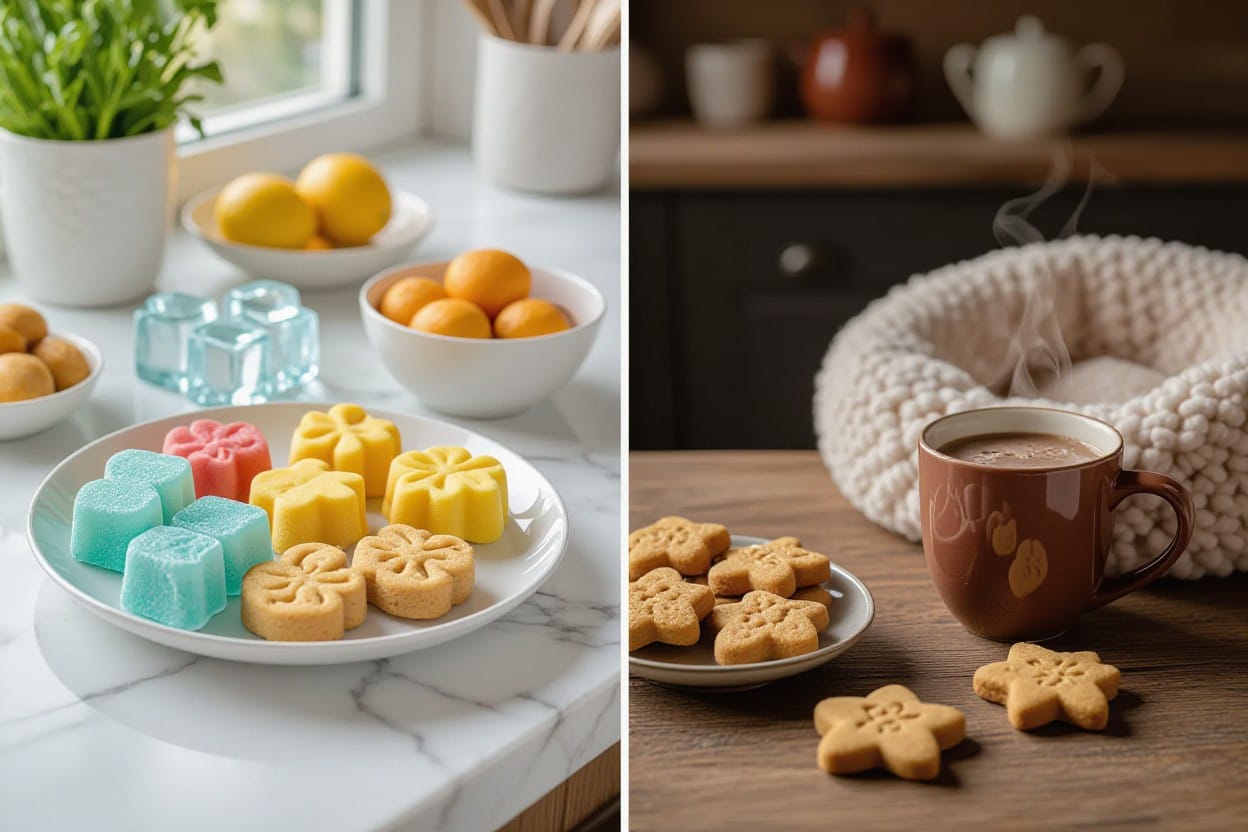
Vet Consultation Reminders
Importance of Professional Guidance
Talk to your veterinarian before introducing a new lineup of cooling treats for cats or switching to winter warming cat treats if your cat has preexisting conditions such as diabetes, chronic kidney disease, food allergies, or a history of pancreatitis. Vets can interpret bloodwork and urinalysis results, recommend appropriate ingredient swaps (for example, low-phosphorus proteins for kidney patients), and calculate safe portion sizes—generally keeping treats under 10% of your cat’s daily caloric intake to avoid weight gain and nutrient imbalance.
Bring ingredient lists or recipe notes for any seasonal cat recipes you plan to use, including frozen cat treats homemade summer variations that contain dairy or added salt. Your vet can advise on safe substitutions (plain canned pumpkin for fiber, cooked white fish without bones for protein), appropriate frequency, and signs to monitor during the first 48–72 hours after introducing a new treat.
Signs That Require Vet Attention
Vomiting more than twice in a 24-hour period, persistent diarrhea beyond 24 hours, refusal to eat for 24–48 hours, or sudden lethargy should prompt immediate contact with your clinic. Watch for difficulty breathing, severe drooling, collapse, seizures, or uncoordinated movements; these are red-flag signs that may indicate acute toxicity (for example, ingestion of onion, garlic, or xylitol) or systemic reactions and require urgent care.
Pale or yellowed gums, rapid breathing, and weakness can be early indicators of hemolytic anemia after exposure to allium foods (onion/garlic), which sometimes shows up 24–72 hours after ingestion. Heatstroke signs in summer—excessive panting, bright red gums, disorientation—are immediate emergencies if a cooling treat for cats causes sudden activity in high temperatures; cool your cat and seek vet care.
Have the treat packaging, a photo of the recipe, and an estimate of how much was eaten ready when you call, and avoid inducing vomiting unless your veterinarian or a poison control professional advises it. Public resources such as the Pet Poison Helpline (855-764-7661) can assist outside clinic hours, but your vet will provide tailored follow-up and treatment plans based on your cat’s weight, age, and clinical signs.
Timing for Seasonal Diet Discussions
Schedule a pre-season checkup about 4–6 weeks before extreme weather shifts so your vet can review body condition, hydration status, and lab work before you introduce summer cat treats or winter warming cat treats. Most adult cats benefit from an annual wellness exam and bloodwork; plan for biannual checks if your cat is over 7 years old or has chronic conditions so adjustments to seasonal cat recipes can be made proactively.
Plan any major recipe testing (for example, trying frozen cat treats homemade summer with small servings) during a window when you can observe your cat for at least 72 hours, and avoid introducing multiple new foods at once. Vets often recommend a gradual introduction schedule and can suggest specific monitoring metrics—weight, stool consistency, water intake—so you can track impact objectively.
Bring recent diet history, photos of the treats or recipes, and any weight logs to your appointment; your vet can then provide a written plan including portion sizes, transition timelines (typically a 5–7 day gradual swap), and lab tests to repeat after diet changes to ensure the new seasonal cat recipes are supporting health without unintended effects.
Special Considerations for Senior Cats
Adjusting Nutritional Needs
Most senior cats benefit from higher-quality protein to preserve lean muscle mass; many commercial senior diets provide roughly 30–40% protein on a dry-matter basis, and you can mirror that in treats by offering small, protein-dense snacks such as shredded cooked chicken or canned tuna (in water) as part of seasonal cat recipes. Hydration becomes more important with age, so incorporate moisture-rich options—frozen cat treats homemade summer like broth-based ice cubes or blended wet food popsicles work well as cooling treats for cats and help counter decreased water intake.
Dental disease and chronic kidney disease (CKD) become more common with age—CKD prevalence rises significantly in cats over 10 years—so adjust treats accordingly by choosing soft, low-phosphorus options if your vet has diagnosed kidney issues. Avoid feeding onions, garlic, grapes, raisins, and products containing xylitol, and always consult your veterinarian before introducing concentrated supplements or switching to calorie-dense toppers for underweight seniors.
Treats for Joint Health
Ingredients with evidence for mobility support include glucosamine/chondroitin and omega-3 fatty acids (EPA/DHA); adding a small amount of fish oil to a warm, palatable topper can reduce inflammation and improve comfort. For a 3–5 kg cat, many practitioners suggest starting at roughly about 1/4 teaspoon of liquid fish oil per day (split doses are fine), but confirm exact dosing with your vet and start low to monitor stool consistency.
Commercial soft chews formulated for cats often deliver measured doses of joint supplements and may be easier to manage than DIY additions; for a seasonal twist, fold powdered glucosamine (veterinary-formulated) into a warm chicken-and-broth mixture as part of your warm cat treats winter recipes to increase intake without forcing large volumes. Avoid human NSAIDs or analgesics—never give ibuprofen or acetaminophen—and check with your vet if your cat is already on anti-inflammatories to prevent interactions.
Palatability matters: offer trial servings and watch for gastrointestinal upset—if stools loosen after adding fish oil, halve the dose and re-evaluate; persistently poor tolerance means switching to EPA/DHA via a veterinary supplement may be necessary.
Monitoring Activity Levels
Set a baseline by tracking daily activity and weight for 2–4 weeks so you can spot deviations; aim for short, low-impact play sessions such as 5–10 minutes twice daily using wand toys or gentle laser bursts to preserve joint function without overexertion. You can use simple logs, smartphone videos, or pet activity monitors to quantify changes in playtime, jump height, and time spent resting versus moving.
Look for specific red flags: reluctance to jump up or down, stiffness after resting, limping, or a weight loss exceeding 5% in one month—any of these warrant veterinary evaluation. Adapt seasonal treats to support activity levels by offering cooling treats for cats after summer play sessions to rehydrate, and warm cat treats winter recipes to entice movement during cold periods.
If you use an activity tracker, compare week-to-week averages rather than single days; many owners find a 10–20% drop in active time over two weeks signals a meaningful decline that should prompt a recheck with the vet.

Cat Treat Preparation Tips
- Portion control: keep treats under 10% of daily calories (adult cat ~200–300 kcal/day).
- Choose water-rich bases for cooling treats for cats and summer cat treats, like low-sodium broth or plain canned pumpkin.
- Avoid toxic ingredients such as onion, garlic, chocolate, grapes, raisins, and xylitol.
- Label and date batches; freeze in individual portions for easy thawing.
Safe Ingredients
Lean, cooked proteins — plain chicken, turkey, or white fish — make reliable bases for both frozen cat treats homemade summer and warm snacks; a tablespoon of cooked chicken is roughly 10–15 kcal, so you can measure portions against your cat’s daily intake. Plain canned tuna in water can be offered occasionally (limit to once or twice weekly) because of mercury accumulation, while small amounts of plain pumpkin (1–2 teaspoons) aid digestion and add fiber without many calories.
Avoid raw dough, bones, and any added seasoning or sauces. Foods that cause toxicity in cats should be flagged: onion, garlic, chocolate, grapes, and artificial sweeteners like xylitol are dangerous even in small amounts. Introduce one new ingredient at a time and monitor your cat for 48 hours for vomiting, diarrhea, or allergic reactions.
Proper Storage Techniques
Place homemade treats in airtight containers and refrigerate for up to 48–72 hours; use glass or BPA‑free plastic and label with the preparation date. For frozen cat treats homemade summer, portion into silicone molds or ice-cube trays and freeze flat so you can remove single servings easily — frozen treats typically keep well for 2–3 months if kept at a constant freezer temperature.
Thaw frozen treats in the refrigerator overnight or in a sealed bag in cool water; never thaw at room temperature for extended periods. Do not refreeze once thawed, and discard refrigerated leftovers that smell off or have changed color or texture.
More storage tips: divide recipes into single-serve portions (1 tablespoon for small cats, up to 1/4 cup for larger breeds) before freezing so you thaw only what you need, and store broths separately from solids to reduce spoilage risk.
Serve with Care
Use treats primarily for enrichment and training, not as meal replacements — keep total treat calories below 10% of daily calories. For frozen treats, supervise the first offering: break large popsicles into bite-sized pieces for adult cats, and shave or soften frozen morsels for kittens and senior cats with dental issues.
Warm winter recipes to lukewarm before serving; test with your fingertip to ensure the temperature is comfortable, and avoid microwaving in a way that creates hot spots. If your cat has food sensitivities, track which ingredients you’ve tested and the response over 48–72 hours before adding them to repeat seasonal cat recipes.
After you’ve seen no adverse reactions for 48–72 hours, rotate safe ingredients and textures between summer cat treats and winter warming cat treats to keep your cat engaged and nourished.
Common Misconceptions About Cat Diets
Myths About Homemade Treats
Many owners assume anything homemade is automatically healthier, yet feeding a steady stream of single-ingredient snacks—like tuna, cooked chicken breast, or milk—can leave gaps in imperative nutrients. Cats are obligate carnivores that require specific amino acids such as taurine (AAFCO minimum ~0.10% on a dry-matter basis) and preformed vitamin A; homemade treats without attention to those needs can contribute to blindness or cardiomyopathy over months. Also avoid ingredients that are toxic to cats, for example onions, garlic, grapes, chocolate, and sweeteners containing xylitol.
When you make frozen cat treats homemade summer-style, choose low-sodium chicken or fish broth, pureed cooked fish, or diluted canned cat food instead of dairy—most adult cats are lactose intolerant and milk can cause diarrhea. Keep treat calories small: a typical indoor cat (~4 kg) needs about 200–250 kcal/day, so let treats remain under 10% of daily calories (roughly 20–25 kcal/day) to avoid unintended weight gain.
Understanding Nutritional Needs
Cat-specific requirements emphasize high-quality animal protein, limited carbohydrates, and micronutrients like taurine, arachidonic acid, and preformed vitamin A. Commercial diets formulated to AAFCO standards typically provide a safe baseline—AAFCO minimum crude protein for adult maintenance is about 26% on a dry-matter basis. Avoid high-carb treats such as bread or starchy human snacks; cats lack the enzymatic profile for heavy carbohydrate digestion and those treats add empty calories.
Balance seasonal cat recipes so treats complement a complete diet rather than substitute for it: small freeze-dried fish bites can be 1–3 kcal each, while a tablespoon of canned tuna is roughly 15–25 kcal, helping you budget calories precisely. For frozen cooling treats for cats, mix measured portions of wet cat food with water or low-sodium broth, pour into ice-cube trays, and log how many cubes equal a single treat serving to keep daily intake consistent.
Micronutrient pitfalls include excessive liver (risk of hypervitaminosis A if fed regularly) and unbalanced calcium:phosphorus ratios if you add bones or bone meal without formulation guidance. Frozen and warm cat treats winter recipes can help hydration and palatability, but supplementation or recipe adjustments should follow specific deficits identified by a nutrition analysis or your veterinarian to avoid long-term deficiencies or toxicities.
Veterinary Insights
Veterinarians often recommend a gradual introduction of any new treat over 7–10 days to monitor tolerance; watch for vomiting, loose stool, changes in coat quality, or increased grooming that may signal food sensitivity. If your cat has obesity, diabetes, or chronic kidney disease, vets will quantify how many treat calories are permissible—often reducing meal calories when treats are added so total daily energy stays within the prescribed target.
Professional caution against raw diets stems from documented risks of bacterial pathogens like Salmonella and Listeria and nutrient imbalances; households with young children, elderly people, or immunocompromised individuals face greater public-health risks from handling raw cat food. For therapeutic needs, vets can recommend specific supplements (for example, taurine at doses around 500–1000 mg/day only if indicated) or commercial fortified options instead of ad hoc homemade mixes.
For cats with medical conditions, your veterinarian or a board-certified veterinary nutritionist should review any warm cat treats winter recipes or frozen cat treats homemade summer plans—especially when managing chronic kidney disease (phosphorus restriction), diabetes (carbohydrate control), or food allergies—because small recipe changes can meaningfully affect medical diets and outcomes.
The Benefits of Seasonal Feeding
Supporting Natural Instincts
Seasonal treats tap into your cat’s preference for temperature and scent: warm broths amplify aroma and mimic the smell of freshly caught prey, while chilled, textured snacks simulate cool prey and encourage licking and chewing. Summer cat treats that include ice or gelled broth satisfy a cat’s need for cooler textures and can make eating more appealing on hot days; offering a few frozen cat treats homemade summer cubes made from low-sodium chicken or tuna water provides both novelty and moisture.
Wet food typically contains about 70–80% moisture compared with dry kibble’s ~5–10%, so integrating seasonal recipes that boost water content helps offset cats’ low thirst drive without forcing extra bowl drinking. Keep a safe-ingredient list handy and avoid known toxins like onions, garlic, chocolate, grapes/raisins, and xylitol when you craft cooling treats for cats or any summer cat treats.
Enhancing Bond with Pet
Preparing seasonal cat recipes becomes a hands-on ritual that strengthens the bond between you and your cat: you control flavors, textures, and temperatures to match your cat’s preferences, and short, positive feeding interactions build trust. Use interactive moments—hand-feeding a lukewarm spoonful of broth or letting your cat lick a frozen treat from a shallow tray—to turn snack time into quality time without overfeeding.
Warming small portions of food or trying simple warm cat treats winter recipes can increase approachability because heat releases volatile aromas that draw your cat in. Always test temperatures on your wrist first and aim for lukewarm, around your cat’s normal body temperature (about 38–39°C); never serve hot to avoid scalds and stress.
Limit treats to no more than 10% of your cat’s daily caloric intake and use seasonal treats as enrichment rather than a main meal; rotating a few trusted recipes keeps interactions novel and reinforces positive behaviors without disrupting balanced nutrition.
Promoting Overall Health
Seasonal feeding supports hydration, digestive regularity, and appetite management: offering cooling treats for cats in summer helps lower heat stress risk by providing extra moisture and a cooling mouthfeel, while winter warming cat treats can stimulate appetite in older or picky cats. Small frozen cubes of diluted, unsalted broth or blended wet food can be given as occasional supplements—serve them in modest amounts, such as a few small cubes per day, to complement regular meals.
Diversifying textures and ingredients through seasonal cat recipes lets you introduce fiber-rich pumpkin for stool consistency or small portions of cooked salmon for omega‑3 fatty acids, while avoiding raw bones and unapproved additives. Consult your veterinarian before adding supplements or if your cat has special dietary needs to ensure treats fit into an overall balanced plan.
Weigh your cat monthly and monitor intake and hydration (sunken eyes, lethargy, tacky gums are warning signs) so you can adjust treat frequency and composition; persistent appetite or hydration changes warrant a vet visit to rule out underlying issues rather than assuming a change in preference alone.

Recipes Adaptation for Food Allergies
Identifying Common Allergens
Beef, dairy, fish, chicken, wheat and soy rank among the most frequently reported food allergens in cats; eggs and some novel proteins can also trigger reactions. Watch for gastrointestinal signs like vomiting or diarrhea and dermatologic signs such as intense itching, hair loss, or recurrent ear infections. If you observe facial swelling, wheezing, or difficulty breathing, treat that as an emergency and seek veterinary care immediately.
Track reactions by introducing one new treat at a time for 7–14 days and keeping treats to less than 10% of daily calories so they don’t mask signals from the main diet. Standard diagnostic practice uses an 8–12 week elimination trial with a single protein source or a hydrolyzed diet to confirm triggers; you can apply the same disciplined approach to test seasonal recipes like frozen cat treats homemade summer or warm cat treats winter recipes.
Alternatives to Common Ingredients
If your cat reacts to chicken or beef, swap in novel proteins such as rabbit, venison, duck or quail for both cooling treats for cats and winter warming cat treats—these proteins often reduce cross-reactivity. Dairy-sensitive cats do better with lactose-free cat milk, plain canned pumpkin, or low-sodium bone broth as bases; avoid regular cow’s milk and yogurt unless your vet has tested tolerance. Do not use onions, garlic, chocolate, grapes, or xylitol under any circumstances, as those are toxic to cats.
For grain or soy sensitivities, use single-ingredient binders like cooked sweet potato, plain cooked rice, or oat flour; egg-free recipes can rely on unflavored gelatin or mashed pumpkin to set textures. Example swaps: transform a summer cat treats yogurt pop into a frozen cat treats homemade summer cube by replacing yogurt with pureed turkey and pumpkin, then freeze in an ice-cube tray for portion control.
Commercial options such as veterinary-prescribed hydrolyzed diets or novel-protein canned foods can be used as bases for seasonal cat recipes when you need strict control; always read labels for hidden additives and choose low-sodium broths and single-ingredient canned proteins when making batch treats at home. Keep portions small—1–2 teaspoons or a 5–10 kcal cube per treat is a practical target while you test tolerance.
Customizing Recipes
Start customization by committing to a single-ingredient treat during an elimination window: prepare small batches using one novel protein and a simple binder (pumpkin, sweet potato, or low-sodium broth). Maintain the elimination period for 8–12 weeks before reintroducing another ingredient, then reintroduce ingredients one at a time and observe for 2 weeks to detect delayed reactions. For seasonal use, you can scale recipes into frozen cat treats homemade summer (pureed single protein + broth) or warm cat treats winter recipes (slow-simmered single-protein broth thickened with pumpkin).
Adjust texture and portioning for age, dental health, and weight: blend to a smooth puree for senior cats or soften chunks for younger cats, and reduce treat frequency for overweight animals so treats remain under 10% of daily caloric intake. Use ice-cube trays or silicone molds to standardize sizes—each cube will typically contain 5–15 kcal depending on ingredients, making tracking straightforward.
Document each batch (ingredient, date, portion size) and freeze small test batches so you can safely trial new seasonal cat recipes without wasting food; consult your veterinarian for any history of severe reactions or to calculate precise caloric allowances tailored to your cat’s weight and health status. Accurate records and controlled reintroduction are the fastest route to safe, enjoyable cooling treats for cats and comforting winter warming cat treats you both can trust.
Conclusion
Summing up, when you prepare cooling treats for cats in the heat, focus on simple, safe ingredients and controlled portions so your pet stays hydrated and comfortable; summer cat treats like brothy ice cubes and blended puree pops or frozen cat treats homemade summer options let you manage flavor and nutrition while reducing heat stress. By prioritizing single-protein bases and minimal additives, you give your cat reliable relief and support digestive health through the season.
As temperatures drop, shift to winter warming cat treats that provide gentle calories and comfort—small warm broths, lightly cooked fish or poultry, and soft stews adapted into warm cat treats winter recipes work well—and use seasonal cat recipes that balance moisture and energy for steady weight and coat condition; consulting your veterinarian helps you tailor treats to your cat’s health needs so your approach stays safe and effective year-round.
FAQ
Q: What ingredients are safe and cat-friendly for cooling treats for cats during hot weather?
A: Cat-safe cooling treats should be high in animal protein, low in additives, and hydrating. Good choices: plain cooked chicken or turkey (no seasoning), canned tuna or salmon in water (drained or use the water to make ice cubes), low-sodium chicken or turkey broth without onion/garlic, and small amounts of plain lactose-free yogurt if your cat tolerates dairy. Avoid onion, garlic, salt, alcohol, chocolate, grapes/raisins, xylitol, and any artificial sweeteners. Use these ingredients as bases for summer cat treats and for frozen cat treats homemade summer recipes to boost hydration.
Q: How do I make quick frozen cat treats homemade summer that my cat will enjoy?
A: Blend cooked, unseasoned chicken or canned tuna with reserved water or low-sodium broth until smooth. Pour into silicone molds or ice cube trays in 1–2 teaspoon portions and freeze for 2–4 hours. For variety, mix in a spoonful of plain pumpkin or a bit of lactose-free yogurt before freezing. Thaw a cube for a few minutes before serving so it’s not too hard. These frozen cat treats homemade summer are excellent cooling treats for cats and can be offered a few times per week as occasional treats.
Q: What are simple warm cat treats winter recipes to comfort cats in cold months?
A: Warm options include gently warmed plain bone broth (cooled to a safe, lukewarm temperature) served with small shreds of cooked chicken or fish, or a puree of cooked turkey mixed with a spoonful of warm plain pumpkin. Another option is lightly baked cat cookies made from canned salmon, an egg, and oat flour—bake small bites until firm and cool to serving temperature. These winter warming cat treats and warm cat treats winter recipes should be served in small portions and tested for tolerance.
Q: How can I adapt seasonal cat recipes for cats with health conditions or dietary restrictions?
A: For kidney disease, use lower-phosphorus proteins and avoid high-sodium broths; prioritize high-moisture options like diluted canned food or broth-based frozen cubes. For weight management, reduce portion size and choose lean proteins like turkey breast. For food allergies, use a novel single protein (e.g., rabbit or duck) and simple bases (broth or pureed pumpkin) to test tolerance. Always consult your veterinarian before introducing seasonal cat recipes for cats with medical conditions to ensure safe ingredient selection and portioning.
Q: How often should I give cooling treats for cats and what safety precautions should I follow?
A: Offer cooling treats for cats as occasional snacks—typically 1–2 small frozen or warm bites a day depending on your cat’s size and overall calorie intake. Check that frozen treats are softened slightly so they aren’t too hard to bite. Monitor for vomiting, diarrhea, allergic reactions, or changes in appetite. Keep preparation surfaces clean, store homemade treats in sealed containers in the fridge (up to 48 hours) or freezer (up to 1 month), and avoid adding salt, sugar, or seasoning when making summer cat treats or winter warming cat treats.
